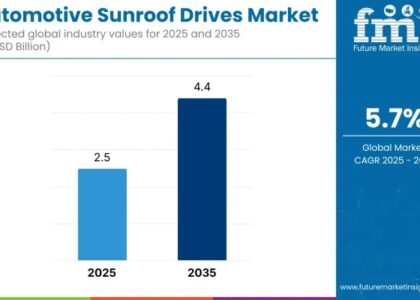The plastic market is typically analyzed through familiar themes—packaging waste, consumer recycling behavior, or regulatory bans on single-use items. However, beneath these headline topics, a deeper structural transformation is taking place, driven by the convergence of carbon pricing mechanisms and circular economy mandates. This shift is turning plastic from a cost-driven commodity into a regulated material asset, tightly bound to carbon emissions accountability and lifecycle management. While these dynamics receive minimal attention in mainstream reports, they are quietly defining the future contours of the global plastic industry.
According to Future Market Insights, the global plastic market is projected to attain a valuation of USD 768.9 billion in 2025 and is expected to reach USD 1,138.9 billion by 2035, expanding at a CAGR of 4% during the forecast period.
Carbon Pricing: The Emerging Cost of Emissions in Plastics
Plastics are made primarily from fossil fuels, making their production one of the most carbon-intensive activities in the manufacturing sector. With increasing global alignment around carbon accounting and emissions trading, carbon-intensive materials like virgin polymers are gradually being reclassified as liabilities. This is especially evident in regions implementing emissions trading schemes, carbon taxes, or supply chain emissions disclosures.
𝐌𝐚𝐤𝐞 𝐈𝐧𝐟𝐨𝐫𝐦𝐞𝐝 𝐃𝐞𝐜𝐢𝐬𝐢𝐨𝐧𝐬 – 𝐀𝐜𝐜𝐞𝐬𝐬 𝐘𝐨𝐮𝐫 𝐒𝐚𝐦𝐩𝐥𝐞 𝐑𝐞𝐩𝐨𝐫𝐭 𝐈𝐧𝐬𝐭𝐚𝐧𝐭𝐥𝐲! https://www.futuremarketinsights.com/reports/sample/rep-gb-15157
The cost implications are already materializing. For example, virgin polyethylene and polypropylene resins now face growing scrutiny from downstream buyers seeking to reduce Scope 3 emissions. Multinational corporations are requiring emissions data for raw materials in their supply chains, and plastics—especially those not derived from recycled or bio-based sources—are emerging as red flags in sustainability audits.
Investors, too, are factoring carbon intensity into material risk assessments. Financial institutions and ESG-focused funds are beginning to differentiate between companies using low-carbon plastics versus those still heavily reliant on virgin fossil feedstocks. This carbon cost calculus is beginning to influence procurement strategies, pricing models, and long-term contracting in the plastic market.
Circular Economy Regulation: A New Mandate for Material Reuse
While the term “recycling” has been associated with plastics for decades, the circular economy represents a broader mandate—one that reimagines how plastic is designed, used, and recovered. Rather than focusing solely on end-of-life disposal, circularity places responsibility at the production level. Manufacturers are now being tasked with designing products for recyclability, incorporating recycled content, and minimizing raw material input through better efficiency and design.
The introduction of recycled content thresholds—backed by enforcement and penalties—is shifting market incentives. Packaging materials are increasingly required to contain minimum percentages of post-consumer recycled (PCR) content. This has fueled a surge in demand for high-quality recycled polymers such as rPET, rHDPE, and rPP, creating a secondary market that operates under distinct pricing and quality pressures from virgin plastics.
The gap between demand for recycled plastics and the available supply has become a central bottleneck. This scarcity is encouraging investment in advanced recycling technologies such as pyrolysis and chemical depolymerization, which allow mixed and contaminated plastic waste to be converted back into feedstock. While these technologies remain in early commercialization stages, their potential to decouple plastics from landfill dependency is gaining traction among policymakers and investors alike.
𝐔𝐧𝐥𝐨𝐜𝐤 𝐂𝐨𝐦𝐩𝐫𝐞𝐡𝐞𝐧𝐬𝐢𝐯𝐞 𝐌𝐚𝐫𝐤𝐞𝐭 𝐈𝐧𝐬𝐢𝐠𝐡𝐭𝐬 – 𝐄𝐱𝐩𝐥𝐨𝐫𝐞 𝐭𝐡𝐞 𝐅𝐮𝐥𝐥 𝐑𝐞𝐩𝐨𝐫𝐭 𝐍𝐨𝐰: https://www.futuremarketinsights.com/reports/plastic-market
Product Redesign: The Rise of Mono-Materials and Minimalism
In a world increasingly governed by lifecycle assessments and digital material passports, product design is taking center stage. Designers and manufacturers are adopting mono-material approaches—using a single type of plastic for entire components or packages—to improve recyclability. Laminates, multi-layer composites, and carbon black additives are being phased out due to their negative impact on material recovery and sorting accuracy.
This shift is not purely technical; it’s strategic. Mono-materials support more efficient post-consumer sorting, reduce contamination in recycling streams, and align with regulatory frameworks that reward recyclability. Major brands in consumer goods and electronics are investing in minimalist designs that reduce the overall plastic content while ensuring compatibility with mainstream recycling infrastructure.
Furthermore, the emergence of digital traceability tools—such as blockchain-based certification or smart labeling—enables supply chains to track and verify the origin, composition, and recyclability of plastic products. These innovations are setting new standards in product transparency and material accountability.
Global Trade and Compliance: The Plastic Passport Era
As plastic products and packaging cross borders, they are increasingly subject to trade-related compliance standards. The concept of a “plastic passport”—a digitally stored declaration of material type, recyclability, carbon footprint, and source—is gaining traction as a requirement in international procurement and customs.
This trend is especially important in the context of trade between countries with strict environmental controls and those with looser regulations. Exporters must now prove that their plastic products meet recyclability criteria or include minimum recycled content levels. Failure to do so can result in trade restrictions, penalties, or loss of market access.
In addition to trade friction, this development signals a new phase in global material governance. Plastics are no longer evaluated only on functional or aesthetic properties—they must now meet complex environmental and compliance metrics across jurisdictions.
Polymers & Plastics Industry Analysis: https://www.futuremarketinsights.com/industry-analysis/polymers-and-plastics
A Market in Transition: From Waste to Circular Resource
The traditional view of the plastic market as a linear supply chain—from resin production to product manufacturing to disposal—is being rapidly replaced by a circular model that treats plastics as recoverable, traceable, and accountable materials. This transition is not being led by consumer demand alone but by financial, regulatory, and technological pressures that are forcing change across the value chain.
Forward-thinking players in the market are moving quickly to adapt—developing closed-loop supply systems, investing in recycled content innovation, and aligning with emerging carbon and materials legislation. Those who lag behind are already encountering rising costs, reputational risk, and shrinking access to high-value markets.
The End of Business-as-Usual for Plastics
The future of the plastic market hinges not only on consumption volumes or recycling rates but on the industry’s ability to internalize the true environmental cost of materials. Carbon pricing and circular mandates are reframing the conversation—turning plastic from a passive input into a regulated, strategic resource.
As plastics become measurable units of carbon and compliance, the market will be led not by those who produce the most, but by those who manage the material lifecycle most efficiently. In this new era, adaptability, innovation, and environmental alignment are the keys to sustained competitiveness in the global plastic market.
Top Segments Studied in the Plastic Market Research Report
By Product:
Polyethylene (PE), Polypropylene (PP), Polyurethane (PU), Polyvinyl chloride (PVC), Polyethylene terephthalate (PET), Polystyrene (PS), Acrylonitrile butadiene styrene (ABS), Polybutylene terephthalate (PBT), Polyphenylene Oxide (PPO), Epoxy Polymers, Liquid Crystal Polymers, Polyether ether ketone (PEEK), Polycarbonate (PC), Polyamide (PA), Polysulfone (PSU), Polyphenylsulfone (PPSU), Others
By Application:
Injection Moulding, Blow Moulding, Roto Moulding, Compression Moulding, Casting, Thermoforming, Extrusion, Calendering, Others
By End-use:
Packaging, Construction, Electrical & Electronics, Automotive, Medical Devices, Others
By Region:
North America, Latin America, Western Europe, Eastern Europe, South Asia and Pacific, East Asia, The Middle East
About Future Market Insights (FMI)
Future Market Insights, Inc. (ESOMAR certified, recipient of the Stevie Award, and a member of the Greater New York Chamber of Commerce) offers profound insights into the driving factors that are boosting demand in the market. FMI stands as the leading global provider of market intelligence, advisory services, consulting, and events for the Packaging, Food and Beverage, Consumer Technology, Healthcare, Industrial, and Chemicals markets. With a vast team of over 400 analysts worldwide, FMI provides global, regional, and local expertise on diverse domains and industry trends across more than 110 countries.
Join us as we commemorate 10 years of delivering trusted market insights. Reflecting on a decade of achievements, we continue to lead with integrity, innovation, and expertise.
Contact Us:
Future Market Insights Inc.
Christiana Corporate, 200 Continental Drive,
Suite 401, Newark, Delaware – 19713, USA
T: +1-347-918-3531
For Sales Enquiries: sales@futuremarketinsights.com
Website: https://www.futuremarketinsights.com
LinkedIn| Twitter| Blogs | YouTube





